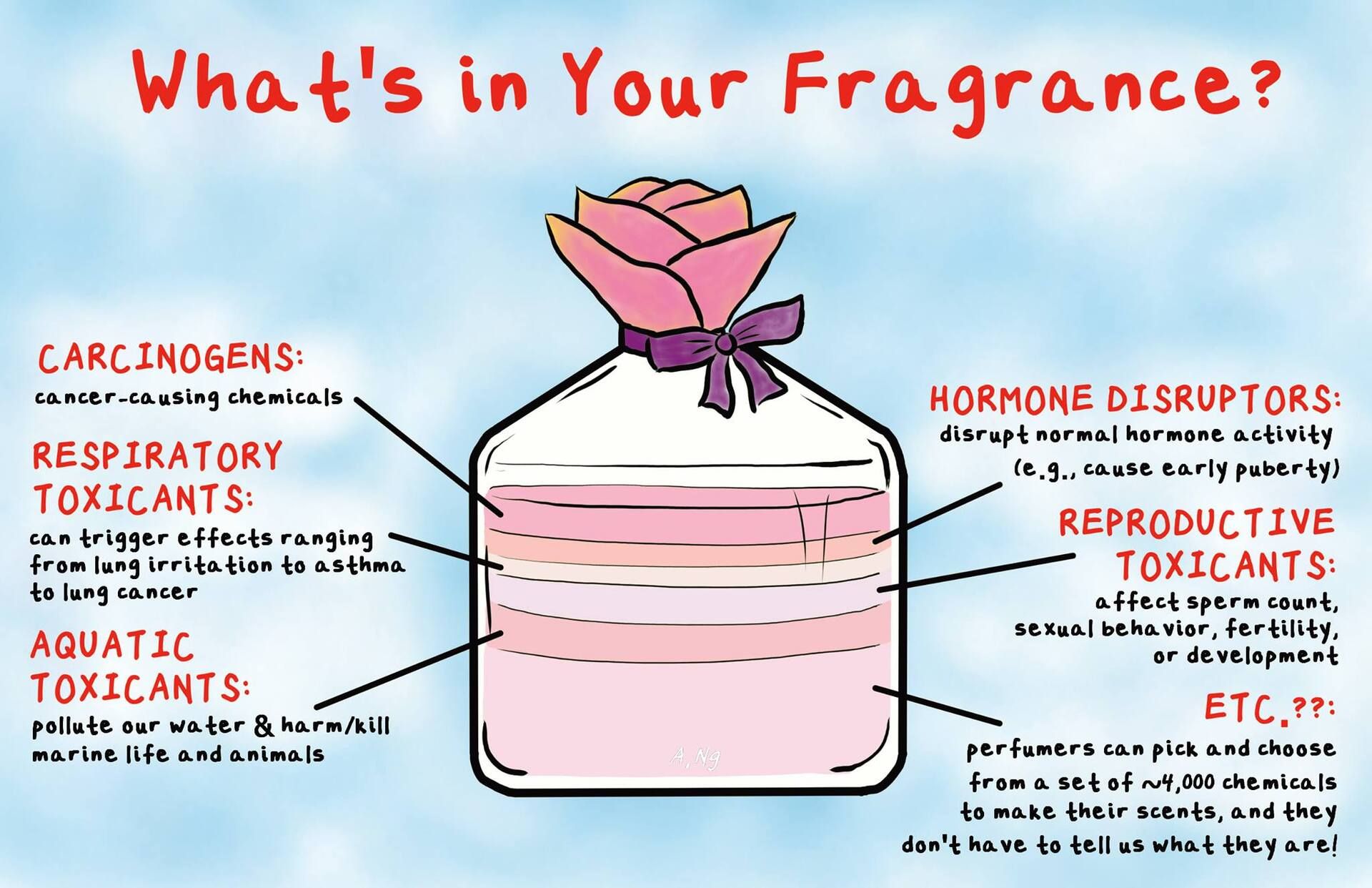- Kiki's Guide
- Posts
- The Hidden Smell
The Hidden Smell
What “Fragrance” in Your Products Really Means (and Why Your Hormones Care)
You know that moment when you open a new shampoo or light a candle and think, “Wow, that smells amazing”?
We humans are scent-driven creatures — our brains are wired to connect smell with comfort, attraction, memory, and even identity. But beneath that pleasant experience lies one of the least transparent corners of the wellness world: fragrance.
Let’s break down what “fragrance” really means, why it’s largely unregulated in the U.S., and how it can quietly impact your health and hormones.
1. What “Fragrance” Really Means in the United States
When you see “fragrance” or “parfum” on a label, it sounds straightforward — maybe it’s a few essential oils or flower extracts.
In reality, that one word can represent hundreds of undisclosed chemicals.
Under the Fair Packaging and Labeling Act (FPLA), cosmetic and personal-care manufacturers must list ingredients — except when they claim “fragrance” as a trade secret. The FDA explicitly allows companies to group scent ingredients under a single umbrella term to protect proprietary blends (FDA.gov).
That means you and I have no way of knowing what’s actually inside. It could be a mix of natural extracts — or synthetic compounds linked to hormone disruption, allergies, and respiratory irritation.
In the EU, more than 3,000 fragrance chemicals are cataloged, and several are restricted due to potential toxicity. In the U.S.? Many of those same chemicals remain fully legal and unlabeled.
2. The Science: Why Our Bodies Care
We’re wired for scent — and exposure.
Scent travels directly to the limbic system, the part of your brain tied to memory and emotion.
When you apply fragrance to skin or hair, or even walk into a scented room, those volatile molecules enter your body through inhalation and absorption.
Because fragrance compounds are so pervasive — from laundry detergent to dry shampoo — most Americans are exposed to multiple products daily. The Environmental Working Group found that the average woman uses 12 products a day containing 168 different chemicals, many under the umbrella of “fragrance” (EWG Report).
Endocrine-disrupting chemicals (EDCs) are compounds that interfere with the body’s hormonal system — affecting everything from fertility to metabolism to mood.
Common fragrance ingredients such as phthalates (used to make scent last longer) and certain synthetic musks have been linked to hormonal disruption in both men and women (NIEHS).
A 2025 study reviewing designer perfumes found suspected endocrine disruptors in every sample tested (CHEM Trust).
Other research connects paraben and phthalate exposure to altered reproductive hormone levels and reduced fertility outcomes in both sexes (PMC6295794; PMC11672798).
We live in a time when fertility is declining across developed nations. While many factors contribute — diet, stress, environment — fragrance chemicals are part of that cumulative body burden we can actually control.

3. Why Transparency Is So Limited
Fragrance is big business — and its secrecy is protected by design.
Manufacturers often guard scent formulas as trade secrets to prevent imitation. That’s understandable for competition, but it creates a black box for consumers.
A 2025 Breast Cancer Prevention Partners analysis found that 42 percent of fragrance ingredients reviewed posed potential high-hazard risks, while more than half lacked basic safety data altogether (BCPP Fragrance Report 2025).
And yes, I’ve tested this myself.
When I reached out to Color Wow through their customer-chat to ask what was in the fragrance of their volumizer, I received a follow-up email — with a definitive “No.”
That’s perfectly legal. But it also means consumers like us are left guessing.

4. Everyday Exposure: The Invisible Load
Fragrance isn’t just in perfume. It’s in:
Shampoo and conditioner
Deodorant and lotion
Laundry detergent and dryer sheets
Cleaning sprays, candles, even trash bags
Even “unscented” products sometimes contain masking fragrances to cover chemical odor.
The American Medical Association has even recognized fragrance sensitivity as a medical disability in healthcare settings (AMA Resolution A-24-501).
That’s how significant these exposures can be for some people.
While a single spritz won’t break your endocrine system, daily, lifelong exposure to dozens of products adds up.
Think of it like a savings account — except you’re depositing small amounts of chemical load instead of money. Over decades, that balance matters.

5. What You Can Do
1️⃣ Start by reading labels.
Look for products labeled “fragrance-free” rather than “unscented” (which can still contain masking scents).
2️⃣ Ask questions.
Email or message companies directly. Even if they decline to share (like Color Wow did with me), each inquiry signals that transparency matters.
3️⃣ Swap intentionally.
Replace one product at a time — maybe your lotion or hair spray — with a clean or fragrance-free alternative.
I’ll list my favorite clean swaps below (you can fill in your picks).
4️⃣ Watch your environment.
Candles, plug-ins, and air fresheners are major culprits for indoor VOCs (volatile organic compounds). Try essential-oil diffusers, beeswax candles, or simply open your windows more often.
5️⃣ Support transparent brands.
Reward companies that publish every ingredient. Clean beauty isn’t about perfection — it’s about honesty.
6. Clean Alternatives I Love
When I vet products, I look for:
Full fragrance-component disclosure
No synthetic musks or phthalates
Plant-based essential oils
Third-party safety certifications (EWG Verified, MADE SAFE, or EcoCert)
7. Podcasts, Books & Resources
🎧 Podcast: The Wellness Collective – episode on fragrance transparency and health.
📚 Reports:
8. Take Action This Week
Audit one product in your daily routine — just one.
Flip the label. If it says “fragrance” without details, email the company.
Notice their response. Do they answer transparently, or hide behind “proprietary blend”?
Then share your findings — tag me @kikis_guide or reply to this email.
Let’s make brand transparency something companies have to talk about because we’re asking the questions.

Fragrance isn’t the villain — secrecy is.
Scent connects us to joy, nostalgia, and even healing — but we deserve to know what we’re inhaling and absorbing.
Your wellness journey doesn’t have to be perfect. It just needs to be intentional.
Every time you swap a product, ask a question, or choose transparency, you’re voting with your dollars for cleaner, clearer wellness.
Here’s to breathing easier — literally and figuratively. 💛

Master ChatGPT for Work Success
ChatGPT is revolutionizing how we work, but most people barely scratch the surface. Subscribe to Mindstream for free and unlock 5 essential resources including templates, workflows, and expert strategies for 2025. Whether you're writing emails, analyzing data, or streamlining tasks, this bundle shows you exactly how to save hours every week.




